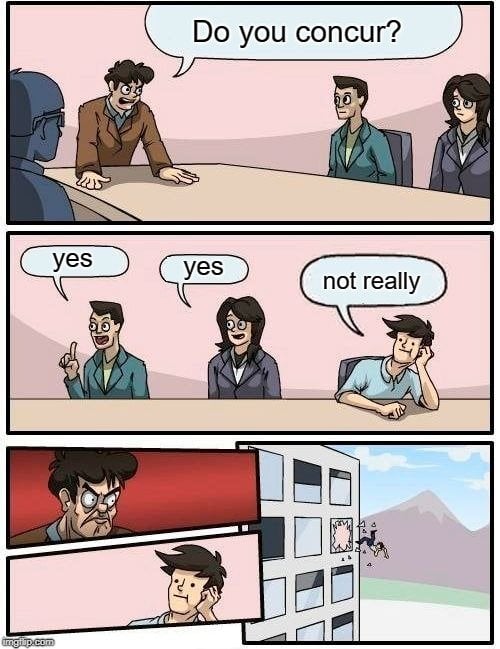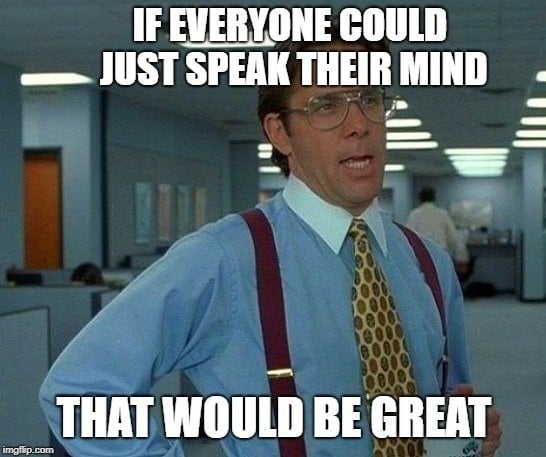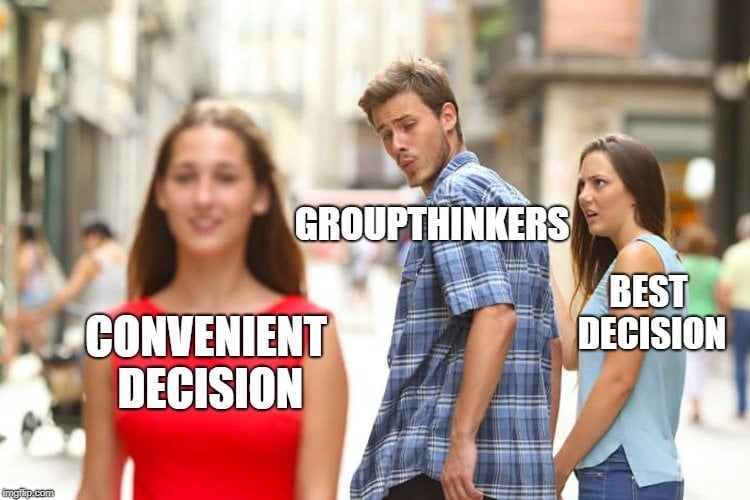Table of Contents (click to expand)
Groupthink is a problem that can occur in groups when the desire for harmony or conformity in the group results in an irrational or dysfunctional decision-making outcome.
Imagine. You and four of your friends are deciding where to go out to eat. You really want to go to that new sushi place in town and you pitch the idea to your friends. They instantly agree—all four of them. Seems strange, doesn’t it? That’s because you’re imagining it! Back in the real world, five people in a group would have five different ideas and you would likely end up discussing the decision for an hour before finally deciding where to eat.
We’ve all made decisions in a group and know how stressful it can get! Different people often view the same situation differently. Some people can’t bear the idea of losing an argument, while others simply don’t want to make decisions. However, we can all agree that group decision-making does facilitate a variety of different approaches to a problem, which one individual may not be capable of, and leads to decisions that represent a greater sum of knowledge, experience and information.
However, what happens when the tendency to maintain unity in a group is so high that you’re not allowed to have different opinions? What happens when no one dares to disagree?

Recommended Video for you:
What Is Groupthink?
Groupthink happens when groups strive for extreme consensus at the cost of effective decision making. They are more concerned with maintaining the unity of the group than with making the best decision. In such cases, independent thinking of group members is frowned upon and alternate suggestions are overridden in a bid to attain concurrence.

The group members in such a situation hold an unquestioned belief and have overconfidence in the group’s competence and morality, so much so that they may not question even ethically dubious decisions and actions of the group. Maintaining group loyalty becomes more important than putting forth one’s views.
How do you identify the presence of groupthink in your group? Watch out for these peculiar identifiable symptoms:
Interpersonal Pressure
Have you ever agreed with your friends because it was more convenient and made you look better? That’s precisely what happens in the case of interpersonal pressure. The pressure to reach a unanimous decision makes agreement look more desirable than disagreement. In addition to this, aggressive efforts are made in order to discourage and stifle dissent by group members, sometimes even leading to expulsion from the group.

Mind Guards
There are people in a group who purposely omit information that might cause doubts to arise within a group. They present the information in such a way that members of the group will all have the same opinion. If they receive any negative or controversial information, they shelter others from it, in order to preserve the central group idea. They also force any dissenting member into silence by pressuring and convincing him that the group may disintegrate if all the members are not in total agreement.
Self-censorship
Even if a group member has concerns with something that’s going on in the group, he may refrain from confiding to other members about those doubts and issues; he censors his own thoughts and opinions.

Apparent Unanimity
When members of the group censor their own dissension, it works to give the illusion of unanimity to the other group members. Even if many members of the group still disagree, they may not make their concerns known to other members, assuming that everyone else is already in acceptance of the situation.

The final resolutions of the group, therefore, seem to be unanimous, even though there may actually be many members of the group that disagree.
Illusion Of Invulnerability
Members of a group in which no one disagrees with anything may think that the group is performing very well. They are extremely self-assured and confident in the group’s ability to make decisions; they believe that the group as a whole could never go wrong. This overconfidence makes them think that they are strong in the face of any obstacle, allowing them to push aside clear and analytical thinking.
Illusion Of Morality
People have their own individual morals and values that they hold on to with all their heart. However, in the face of group pressures and in a bid to be included, they can lose sight of those morals. Excessive confidence in the overall morality of the group can override any individual sense of right and wrong.
Biased Perceptions Of The Out-group
Members of a tightly cohesive group have a biased perception of any non-group members. They constantly discredit the abilities of the ‘outsiders’ and doubt their intentions. Ultimately, they perceive the outsiders as dumb, evil and/or weak. More importantly, the belief that others are inferior allows them to justify any inhumanity or violence present in their own actions.
Defective Decision-making Strategies
How do you make decisions? You list alternatives, weigh the pros and cons of each alternative, and then choose the best one. However, since many alternatives are omitted in groupthink situations, the decision that is finally made is based on an incomplete review of the issue at hand. In addition to this, there is a conscious omission of information and a focus on only the information that supports their currently agreed-upon course of action. Decisions made by such groups are, therefore, usually not the best ones.

What Causes Groupthink?
There are several well-known causes of groupthink—group cohesiveness, overall isolation of the group, rigid leadership and decisional stress.
We have seen how tightly cohesive groups become obsessed with conformation. The higher the level of cohesiveness, the higher the level of ‘apparent’ unanimity in the group and, therefore, the higher the level of self-censorship. The different perspectives needed to make a good decision are lost in a bid to maintain the cohesiveness of the group.
Just as excess group cohesiveness leads to a lack of perspectives from people within the group, group isolation makes the members lack perspective from people outside the group. Isolated groups often require their decisions and actions to remain secret, and therefore do not seek and incorporate outside opinions in their decision-making process. The absence of criticism, which is a natural result of this isolation, leads to the illusion of the group’s invulnerability and ultimate morality.

Extremely rigid leadership within a group contributes to an environment where no one states their own opinions. Group discussions are tightly controlled and it becomes easy to suppress dissenting opinions by intimidating members or simply not allowing the dissenters to voice their objections.
Decisional stress is another cause of groupthink. Any decision requires some time to be made. When you force people to make an important decision in less time than they need, they will try to reduce this stress and insecurity by any possible means. People usually want to finish making the decision quickly so they don’t feel stressed anymore, or even let someone else make the decision for them.
How Can Leaders Tackle Groupthink?
It’s quite obvious that in order to defeat groupthink, group leaders must create an atmosphere of trust and openness, and encourage people to speak up. However, these are some other things a leader can do:
Devil’s advocate role – Playing the devil’s advocate means taking on the role of fostering argument and conflict. This is one of the oldest and most commonly used tools that can be used to mitigate groupthink bias. Basically, pick the other side and argue for that option/idea.
Encourage diversity – Diversity in the group keeps group cohesiveness in check and increases multiple perspectives. When there are many sources of diversity within the team, members will find themselves unable to form homogenous subgroups and attack others.
Monitor group size – Although there is no magic number, keeping a group lean may help group members speak up, instead of conforming to popular views.
Realize that conflict is not always bad – The way the leader and group members see conflict decides how effective the implementation of other practices will be. Remember… mindset matters! Encouraging authentic dissent, although it’s very important, is easier said than done; accepting dissent is a slow and gradual process. Until this approach is whole-heartedly accepted by all members, minority dissenters might be disliked and treated unfairly.

Teams must, therefore, establish procedures to protect minority dissenters from backlash.
Although the leader is in a position to influence the group the most, eliminating groupthink must be a collective interest of all group members and will require their collective effort to eradicate.
To put it simply….Speak, and let speak!












